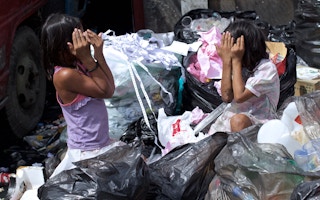New research suggests that plastic recycling facilities could be releasing wastewater packed with billions of tiny plastic particles, contributing to the pollution of waterways and endangering human health.
A team of international scientists sampled water inside a new recycling facility at an undisclosed location in the UK They suggest that the facility could be releasing up to 75 billion microplastics — tiny plastic pieces less than 5 millimetres, or 3/16 of an inch, in length — per cubic meter of wastewater per year.
That’s about 6 per cent of the plastic that entered the facility to be recycled. However, the researchers only considered microplastics as small as 1.6 microns (μm), which means these numbers are likely to be an underestimate, they say.
The researchers tested the wastewater before the facility installed a water filtration system, as well as after the filtration system was installed. They found that while the system filtered out about 90 per cent of the microplastics larger than 10 μm, it didn’t remove the pieces smaller than 10 μm.
The study, which was recently published in the Journal of Hazardous Materials Advances, suggests the recycling plant discharged up to 2,933 metric tons of microplastics each year prior to the water filtration system, and up to 1,366 metric tons of microplastics each year after the system was in place.
“
Given the size of these microplastic particles, the environmental repercussions and risk of ingestion by all manners of invertebrates, biota and humans is worrying.
Deonie Allen, researcher, University of Birmingham
“We wouldn’t have done this study if we hadn’t thought there was any pollution in the water, but it was just shocking numbers,” study lead author Erina Brown, a researcher at the University of Strathclyde in Scotland, tells Mongabay. “Over 80 per cent of the particles that we found were under 10 microns, which have been shown to be really harmful, both to humans and so many different organisms — from large organisms down to tiny zooplankton.”
The world currently produces nearly 400 million metric tons of plastic each year, but only about 9 per cent is recycled. This means that global plastic recycling facilities could be producing about 2 million metric tons of microplastic waste each year, says study co-author Deonie Allen, also from Strathclyde and a microplastics researcher at the University of Birmingham in the UK and the University Canterbury in New Zealand.
“This is not including the other pathways microplastics may be released into our environment,” Deonie Allen says in a statement. “Given the size of these microplastic particles, the environmental repercussions and risk of ingestion by all manners of invertebrates, biota and humans is worrying.”
The results also showed high levels of microplastics in the air around the plastic recycling facility, with 61 per cent of the particles being less than 10 μm in size. Research has suggested that when inhaled, plastics of this size may cause interstitial lung disease and other respiratory illnesses.
“We should definitely start thinking about workers within these plastic recycling facilities, and whether they should wear masks and what remedial impacts we can take to protect the workers who are working within these plants,” Brown says.
Ian Williams, an expert on pollution and waste management at the University of Southampton in the UK, who was not involved in this research, says he agrees with the themes that emerge from the paper.
“Microplastics clearly leak from mixed plastics recycling facilities causing potentially significant [microplastic] pollution releases,” Williams tells Mongabay in an email. “The use of filters for microplastics is highly unlikely to remove very small particles but is likely to be very effective for microplastics >5µm. But regular cleaning and maintenance of such installations will be crucial, and there is the question of what you do with the dirty filters and filtered materials.”
Wastewater polluted with microplastics isn’t the only issue with plastic recycling facilities. Experts say that facilities using “advanced recycling” (or “chemical recycling”) processes can also produce a toxic cocktail of chemical waste, including benzene, lead, cadmium and chromium, and emit hazardous air pollution that can cause severe health problems. However, proponents of these facilities say advanced recycling is a solution to plastic pollution and that these facilities don’t emit more air pollution than food factories.
In March 2022, delegates from 175 countries agreed to develop a legally binding framework to fight global plastic pollution, known widely as the “global plastics treaty.” But nations are still discussing what the treaty should cover, including how the recycling of plastic products should be dealt with, and how the treaty requirements should be implemented.
“With the plastic treaty entering its second round and plastic recycling being touted as the solution, it is apparent that more responsibility on proper handling of plastic is desperately needed,” Steve Allen, a microplastics expert at the Ocean Frontier Institute at Dalhousie University in Canada, says in a statement. “A plant leaking that much plastic as part of a state-of-the-art operation, is just utterly shameful.”
Brown says she doesn’t necessarily want the study to suggest that recycling should be stopped, but that recycling shouldn’t be used to “justify our increasing plastic consumption and production.”
“We really do need to massively reduce our plastic consumption instead of focusing on recycling … and [the study] highlights that it’s so important that we consider the impacts of the solutions that we present,” Brown says, “because otherwise, it just seems a little bit backward, if we end up polluting the same environment that we are intending to protect.”
This story was published with permission from Mongabay.com.










